CHCDIV001: Diversity, Cultural Safety, and Aboriginal Issues Essay
VerifiedAdded on 2023/06/07
|12
|2569
|468
Essay
AI Summary
This essay provides an analysis of diversity within Australian communities, with a particular focus on Aboriginal and Torres Strait Islander people. It begins with a reflection on cultural competence, cultural awareness and diversity, examining how these concepts manifest in the workplace and broader society. The essay then delves into the issues affecting Aboriginal and Torres Strait Islander people, including the impact of historical events like the Stolen Generations, health disparities, and homelessness. It further explores the social, political, and economic factors contributing to these challenges, as well as the ways in which Australian culture, systems, and structures have adversely affected indigenous communities. The essay concludes by outlining personal goals and strategies for developing cultural competence, emphasizing the importance of addressing stereotypes and biases to foster stronger relationships between indigenous and non-indigenous Australians. This paper provides insights into promoting inclusivity and equity within diverse settings.
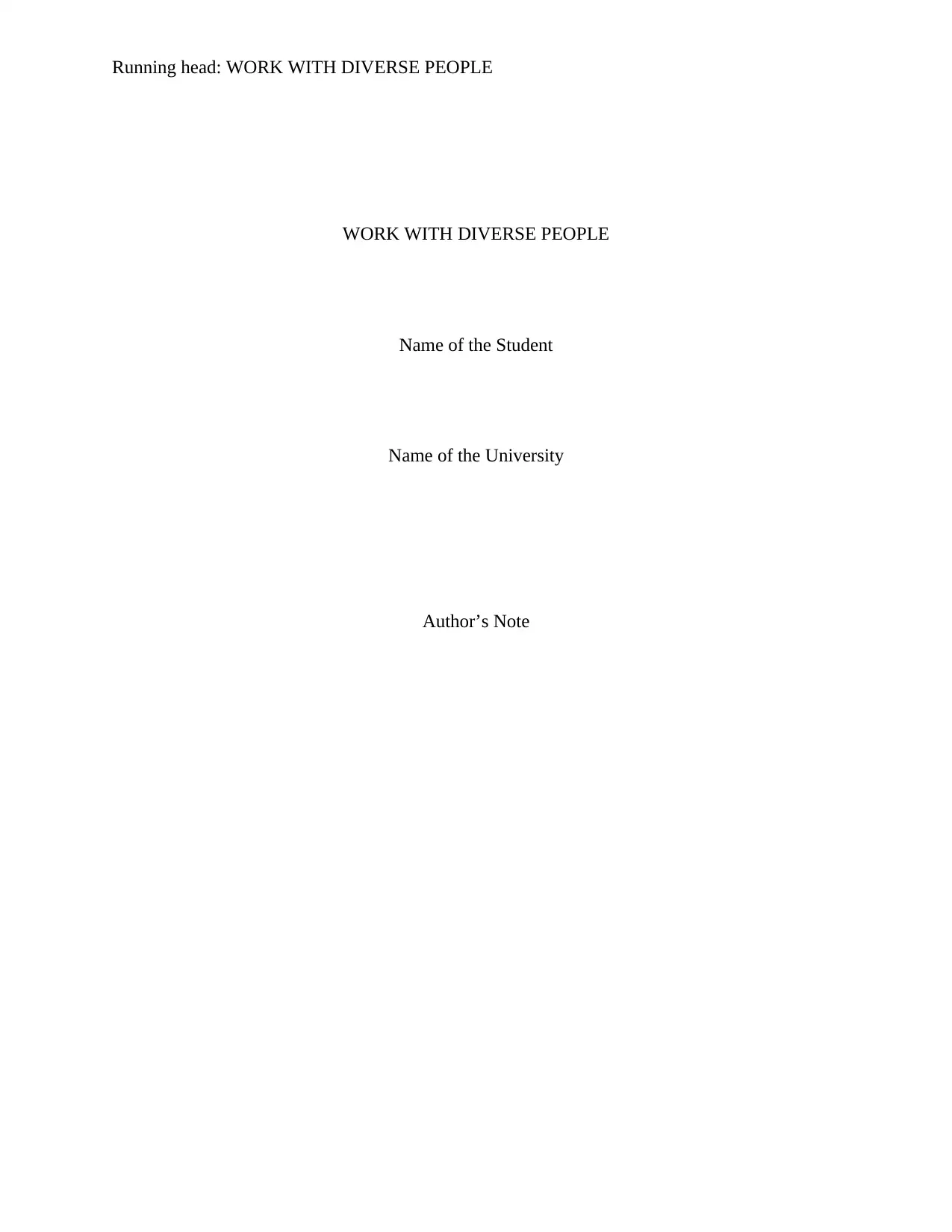
Running head: WORK WITH DIVERSE PEOPLE
WORK WITH DIVERSE PEOPLE
Name of the Student
Name of the University
Author’s Note
WORK WITH DIVERSE PEOPLE
Name of the Student
Name of the University
Author’s Note
Paraphrase This Document
Need a fresh take? Get an instant paraphrase of this document with our AI Paraphraser
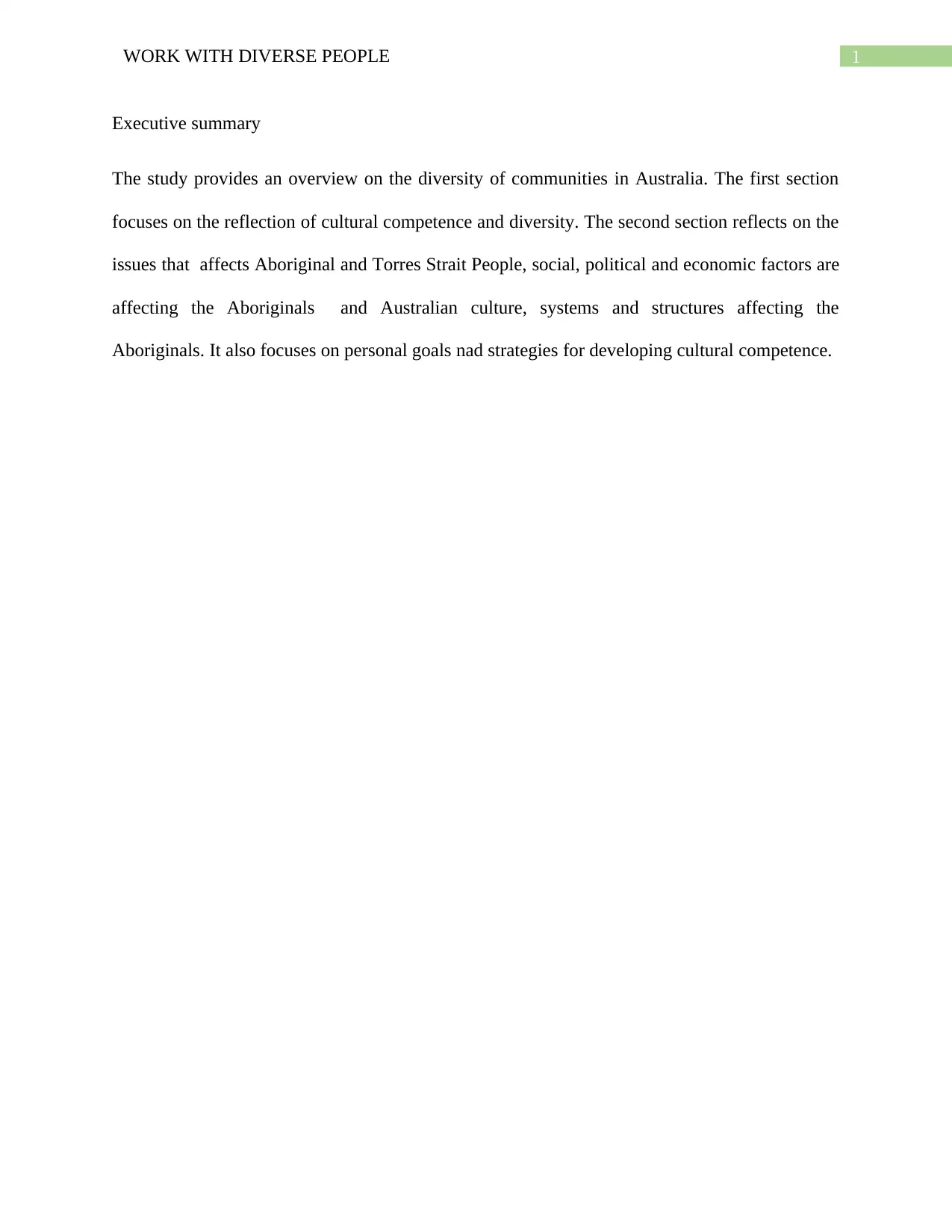
1WORK WITH DIVERSE PEOPLE
Executive summary
The study provides an overview on the diversity of communities in Australia. The first section
focuses on the reflection of cultural competence and diversity. The second section reflects on the
issues that affects Aboriginal and Torres Strait People, social, political and economic factors are
affecting the Aboriginals and Australian culture, systems and structures affecting the
Aboriginals. It also focuses on personal goals nad strategies for developing cultural competence.
Executive summary
The study provides an overview on the diversity of communities in Australia. The first section
focuses on the reflection of cultural competence and diversity. The second section reflects on the
issues that affects Aboriginal and Torres Strait People, social, political and economic factors are
affecting the Aboriginals and Australian culture, systems and structures affecting the
Aboriginals. It also focuses on personal goals nad strategies for developing cultural competence.
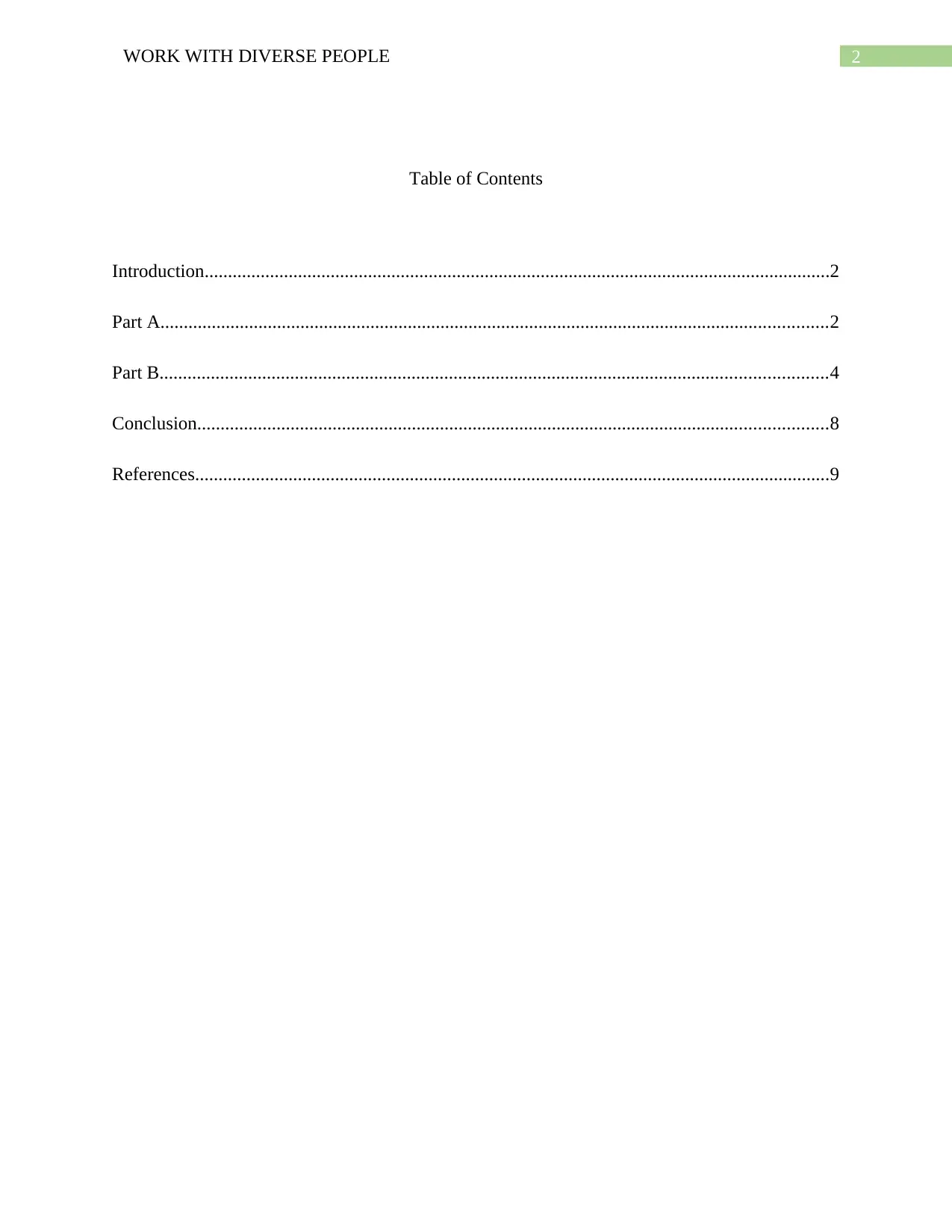
2WORK WITH DIVERSE PEOPLE
Table of Contents
Introduction......................................................................................................................................2
Part A...............................................................................................................................................2
Part B...............................................................................................................................................4
Conclusion.......................................................................................................................................8
References........................................................................................................................................9
Table of Contents
Introduction......................................................................................................................................2
Part A...............................................................................................................................................2
Part B...............................................................................................................................................4
Conclusion.......................................................................................................................................8
References........................................................................................................................................9
⊘ This is a preview!⊘
Do you want full access?
Subscribe today to unlock all pages.

Trusted by 1+ million students worldwide
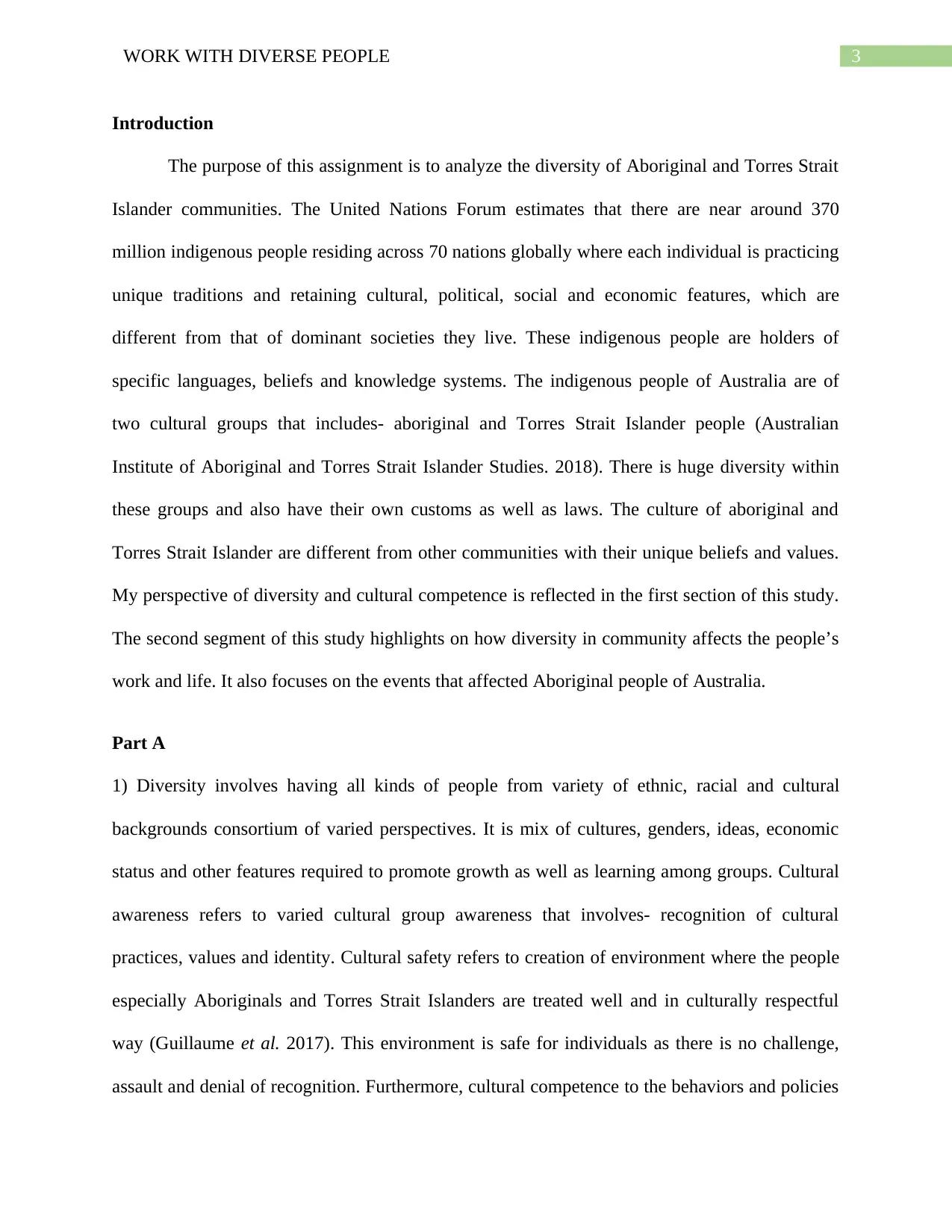
3WORK WITH DIVERSE PEOPLE
Introduction
The purpose of this assignment is to analyze the diversity of Aboriginal and Torres Strait
Islander communities. The United Nations Forum estimates that there are near around 370
million indigenous people residing across 70 nations globally where each individual is practicing
unique traditions and retaining cultural, political, social and economic features, which are
different from that of dominant societies they live. These indigenous people are holders of
specific languages, beliefs and knowledge systems. The indigenous people of Australia are of
two cultural groups that includes- aboriginal and Torres Strait Islander people (Australian
Institute of Aboriginal and Torres Strait Islander Studies. 2018). There is huge diversity within
these groups and also have their own customs as well as laws. The culture of aboriginal and
Torres Strait Islander are different from other communities with their unique beliefs and values.
My perspective of diversity and cultural competence is reflected in the first section of this study.
The second segment of this study highlights on how diversity in community affects the people’s
work and life. It also focuses on the events that affected Aboriginal people of Australia.
Part A
1) Diversity involves having all kinds of people from variety of ethnic, racial and cultural
backgrounds consortium of varied perspectives. It is mix of cultures, genders, ideas, economic
status and other features required to promote growth as well as learning among groups. Cultural
awareness refers to varied cultural group awareness that involves- recognition of cultural
practices, values and identity. Cultural safety refers to creation of environment where the people
especially Aboriginals and Torres Strait Islanders are treated well and in culturally respectful
way (Guillaume et al. 2017). This environment is safe for individuals as there is no challenge,
assault and denial of recognition. Furthermore, cultural competence to the behaviors and policies
Introduction
The purpose of this assignment is to analyze the diversity of Aboriginal and Torres Strait
Islander communities. The United Nations Forum estimates that there are near around 370
million indigenous people residing across 70 nations globally where each individual is practicing
unique traditions and retaining cultural, political, social and economic features, which are
different from that of dominant societies they live. These indigenous people are holders of
specific languages, beliefs and knowledge systems. The indigenous people of Australia are of
two cultural groups that includes- aboriginal and Torres Strait Islander people (Australian
Institute of Aboriginal and Torres Strait Islander Studies. 2018). There is huge diversity within
these groups and also have their own customs as well as laws. The culture of aboriginal and
Torres Strait Islander are different from other communities with their unique beliefs and values.
My perspective of diversity and cultural competence is reflected in the first section of this study.
The second segment of this study highlights on how diversity in community affects the people’s
work and life. It also focuses on the events that affected Aboriginal people of Australia.
Part A
1) Diversity involves having all kinds of people from variety of ethnic, racial and cultural
backgrounds consortium of varied perspectives. It is mix of cultures, genders, ideas, economic
status and other features required to promote growth as well as learning among groups. Cultural
awareness refers to varied cultural group awareness that involves- recognition of cultural
practices, values and identity. Cultural safety refers to creation of environment where the people
especially Aboriginals and Torres Strait Islanders are treated well and in culturally respectful
way (Guillaume et al. 2017). This environment is safe for individuals as there is no challenge,
assault and denial of recognition. Furthermore, cultural competence to the behaviors and policies
Paraphrase This Document
Need a fresh take? Get an instant paraphrase of this document with our AI Paraphraser
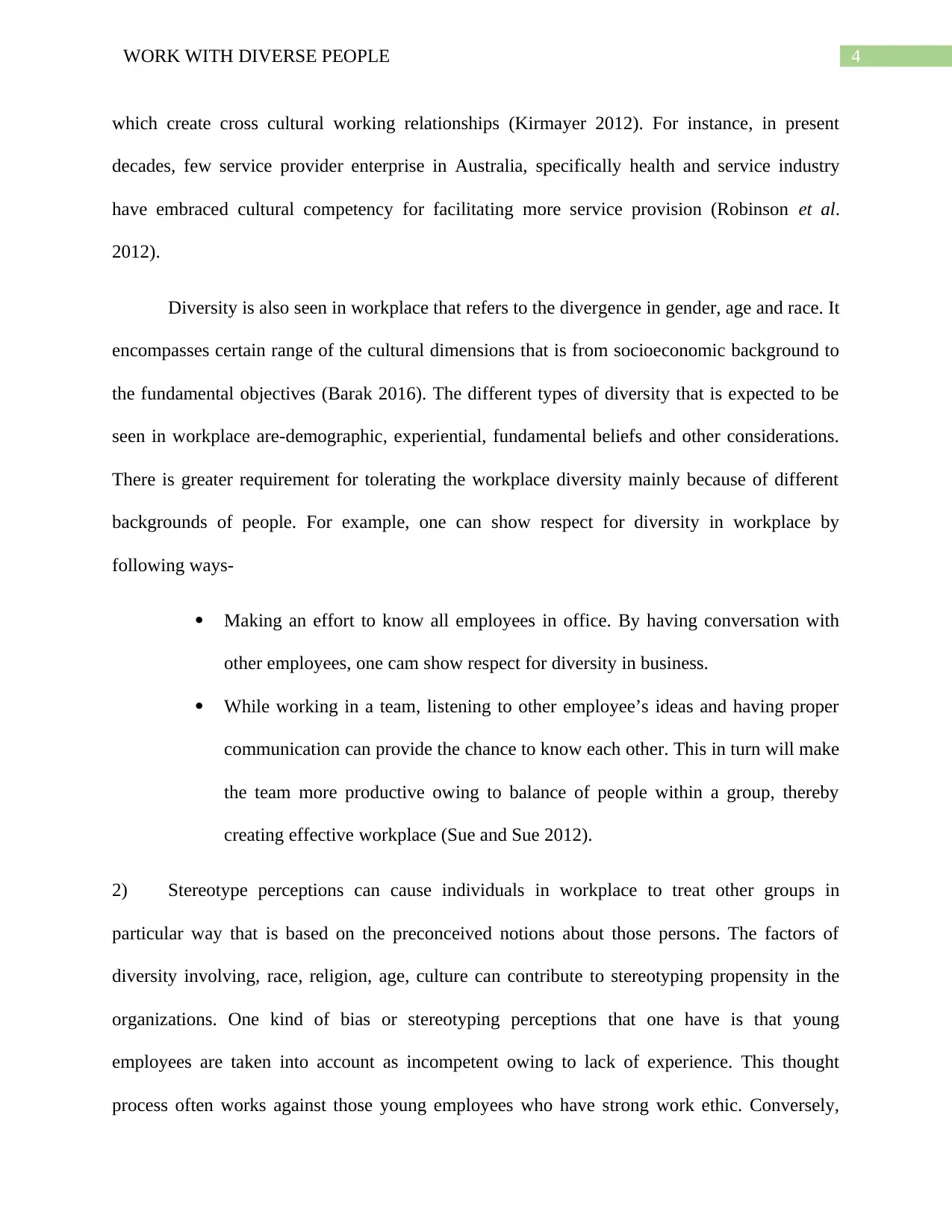
4WORK WITH DIVERSE PEOPLE
which create cross cultural working relationships (Kirmayer 2012). For instance, in present
decades, few service provider enterprise in Australia, specifically health and service industry
have embraced cultural competency for facilitating more service provision (Robinson et al.
2012).
Diversity is also seen in workplace that refers to the divergence in gender, age and race. It
encompasses certain range of the cultural dimensions that is from socioeconomic background to
the fundamental objectives (Barak 2016). The different types of diversity that is expected to be
seen in workplace are-demographic, experiential, fundamental beliefs and other considerations.
There is greater requirement for tolerating the workplace diversity mainly because of different
backgrounds of people. For example, one can show respect for diversity in workplace by
following ways-
Making an effort to know all employees in office. By having conversation with
other employees, one cam show respect for diversity in business.
While working in a team, listening to other employee’s ideas and having proper
communication can provide the chance to know each other. This in turn will make
the team more productive owing to balance of people within a group, thereby
creating effective workplace (Sue and Sue 2012).
2) Stereotype perceptions can cause individuals in workplace to treat other groups in
particular way that is based on the preconceived notions about those persons. The factors of
diversity involving, race, religion, age, culture can contribute to stereotyping propensity in the
organizations. One kind of bias or stereotyping perceptions that one have is that young
employees are taken into account as incompetent owing to lack of experience. This thought
process often works against those young employees who have strong work ethic. Conversely,
which create cross cultural working relationships (Kirmayer 2012). For instance, in present
decades, few service provider enterprise in Australia, specifically health and service industry
have embraced cultural competency for facilitating more service provision (Robinson et al.
2012).
Diversity is also seen in workplace that refers to the divergence in gender, age and race. It
encompasses certain range of the cultural dimensions that is from socioeconomic background to
the fundamental objectives (Barak 2016). The different types of diversity that is expected to be
seen in workplace are-demographic, experiential, fundamental beliefs and other considerations.
There is greater requirement for tolerating the workplace diversity mainly because of different
backgrounds of people. For example, one can show respect for diversity in workplace by
following ways-
Making an effort to know all employees in office. By having conversation with
other employees, one cam show respect for diversity in business.
While working in a team, listening to other employee’s ideas and having proper
communication can provide the chance to know each other. This in turn will make
the team more productive owing to balance of people within a group, thereby
creating effective workplace (Sue and Sue 2012).
2) Stereotype perceptions can cause individuals in workplace to treat other groups in
particular way that is based on the preconceived notions about those persons. The factors of
diversity involving, race, religion, age, culture can contribute to stereotyping propensity in the
organizations. One kind of bias or stereotyping perceptions that one have is that young
employees are taken into account as incompetent owing to lack of experience. This thought
process often works against those young employees who have strong work ethic. Conversely,
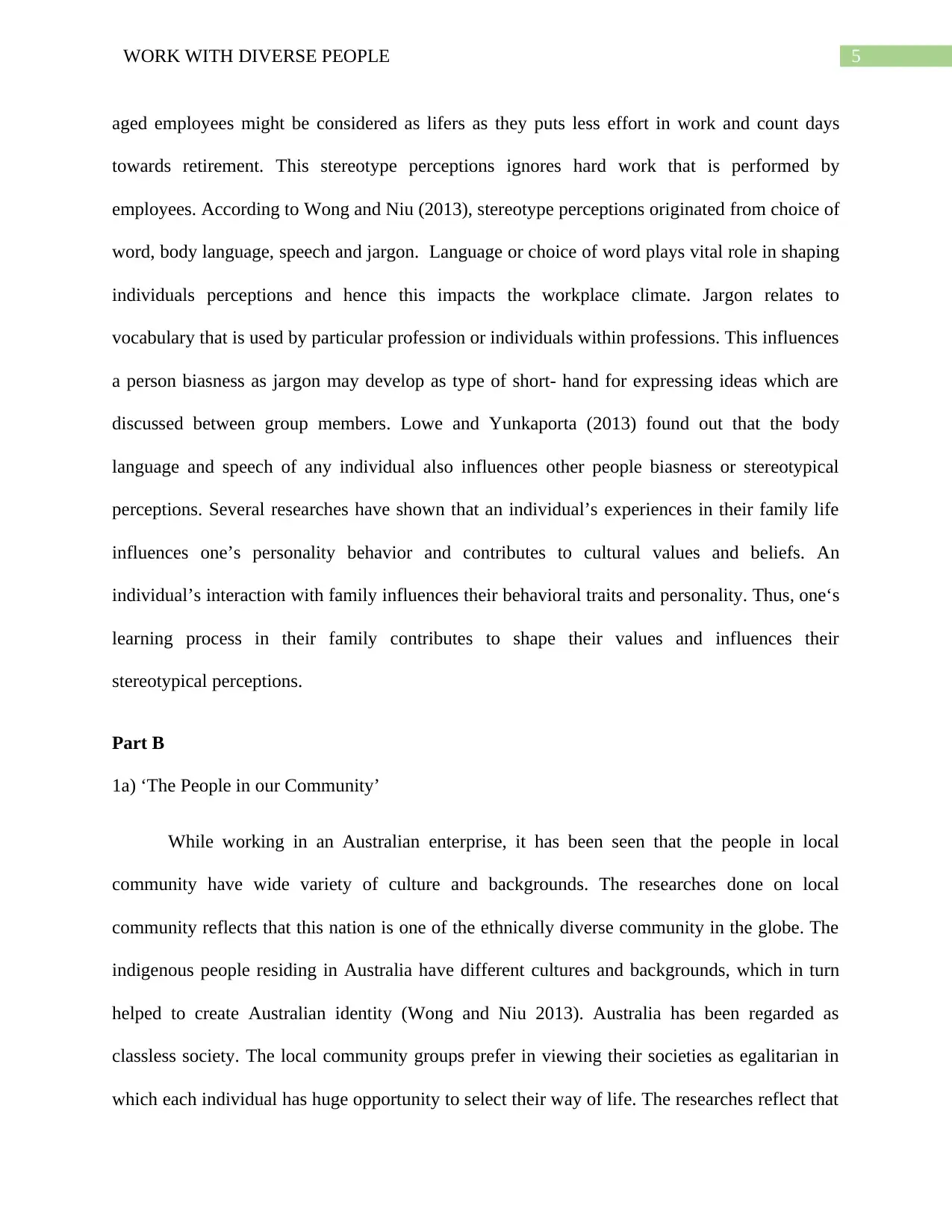
5WORK WITH DIVERSE PEOPLE
aged employees might be considered as lifers as they puts less effort in work and count days
towards retirement. This stereotype perceptions ignores hard work that is performed by
employees. According to Wong and Niu (2013), stereotype perceptions originated from choice of
word, body language, speech and jargon. Language or choice of word plays vital role in shaping
individuals perceptions and hence this impacts the workplace climate. Jargon relates to
vocabulary that is used by particular profession or individuals within professions. This influences
a person biasness as jargon may develop as type of short- hand for expressing ideas which are
discussed between group members. Lowe and Yunkaporta (2013) found out that the body
language and speech of any individual also influences other people biasness or stereotypical
perceptions. Several researches have shown that an individual’s experiences in their family life
influences one’s personality behavior and contributes to cultural values and beliefs. An
individual’s interaction with family influences their behavioral traits and personality. Thus, one‘s
learning process in their family contributes to shape their values and influences their
stereotypical perceptions.
Part B
1a) ‘The People in our Community’
While working in an Australian enterprise, it has been seen that the people in local
community have wide variety of culture and backgrounds. The researches done on local
community reflects that this nation is one of the ethnically diverse community in the globe. The
indigenous people residing in Australia have different cultures and backgrounds, which in turn
helped to create Australian identity (Wong and Niu 2013). Australia has been regarded as
classless society. The local community groups prefer in viewing their societies as egalitarian in
which each individual has huge opportunity to select their way of life. The researches reflect that
aged employees might be considered as lifers as they puts less effort in work and count days
towards retirement. This stereotype perceptions ignores hard work that is performed by
employees. According to Wong and Niu (2013), stereotype perceptions originated from choice of
word, body language, speech and jargon. Language or choice of word plays vital role in shaping
individuals perceptions and hence this impacts the workplace climate. Jargon relates to
vocabulary that is used by particular profession or individuals within professions. This influences
a person biasness as jargon may develop as type of short- hand for expressing ideas which are
discussed between group members. Lowe and Yunkaporta (2013) found out that the body
language and speech of any individual also influences other people biasness or stereotypical
perceptions. Several researches have shown that an individual’s experiences in their family life
influences one’s personality behavior and contributes to cultural values and beliefs. An
individual’s interaction with family influences their behavioral traits and personality. Thus, one‘s
learning process in their family contributes to shape their values and influences their
stereotypical perceptions.
Part B
1a) ‘The People in our Community’
While working in an Australian enterprise, it has been seen that the people in local
community have wide variety of culture and backgrounds. The researches done on local
community reflects that this nation is one of the ethnically diverse community in the globe. The
indigenous people residing in Australia have different cultures and backgrounds, which in turn
helped to create Australian identity (Wong and Niu 2013). Australia has been regarded as
classless society. The local community groups prefer in viewing their societies as egalitarian in
which each individual has huge opportunity to select their way of life. The researches reflect that
⊘ This is a preview!⊘
Do you want full access?
Subscribe today to unlock all pages.

Trusted by 1+ million students worldwide
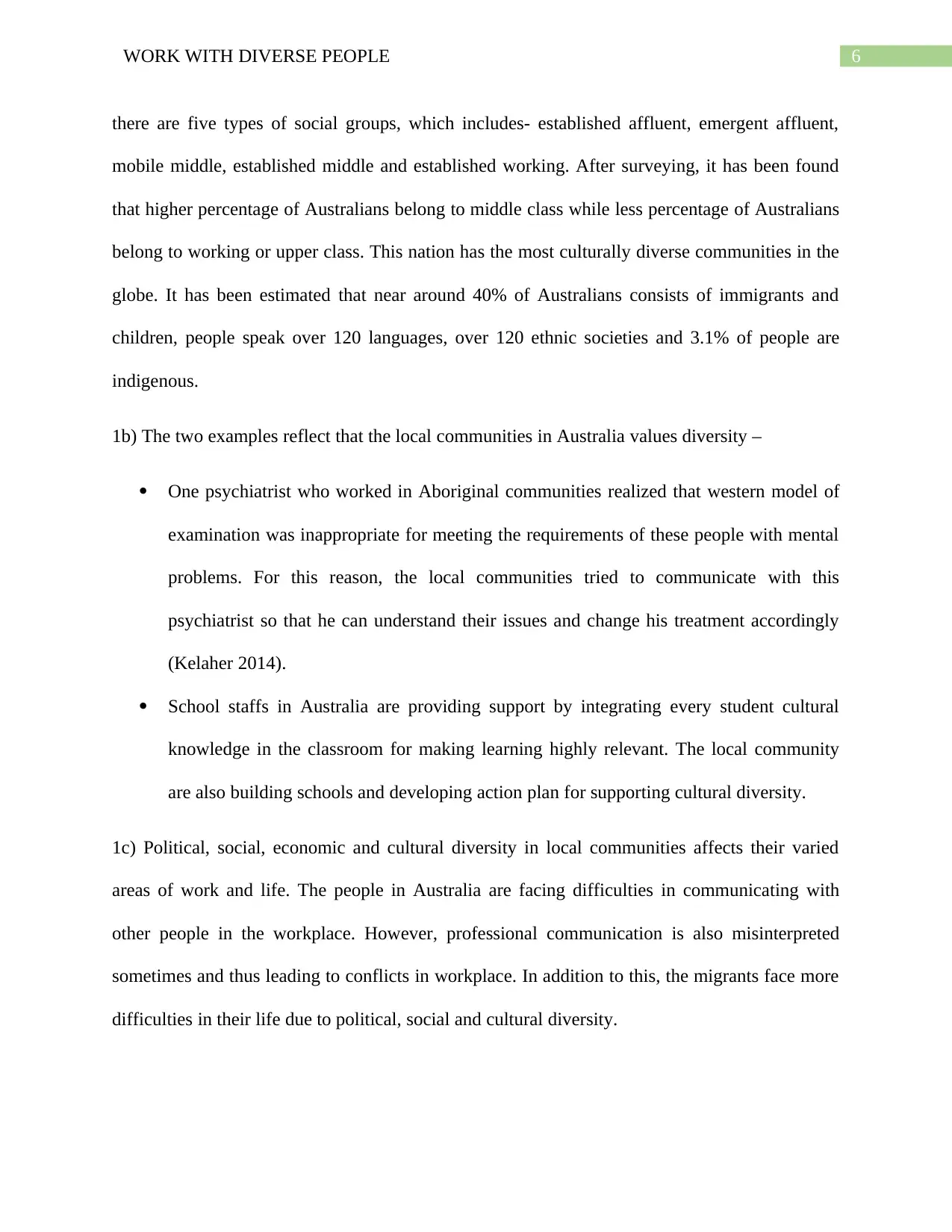
6WORK WITH DIVERSE PEOPLE
there are five types of social groups, which includes- established affluent, emergent affluent,
mobile middle, established middle and established working. After surveying, it has been found
that higher percentage of Australians belong to middle class while less percentage of Australians
belong to working or upper class. This nation has the most culturally diverse communities in the
globe. It has been estimated that near around 40% of Australians consists of immigrants and
children, people speak over 120 languages, over 120 ethnic societies and 3.1% of people are
indigenous.
1b) The two examples reflect that the local communities in Australia values diversity –
One psychiatrist who worked in Aboriginal communities realized that western model of
examination was inappropriate for meeting the requirements of these people with mental
problems. For this reason, the local communities tried to communicate with this
psychiatrist so that he can understand their issues and change his treatment accordingly
(Kelaher 2014).
School staffs in Australia are providing support by integrating every student cultural
knowledge in the classroom for making learning highly relevant. The local community
are also building schools and developing action plan for supporting cultural diversity.
1c) Political, social, economic and cultural diversity in local communities affects their varied
areas of work and life. The people in Australia are facing difficulties in communicating with
other people in the workplace. However, professional communication is also misinterpreted
sometimes and thus leading to conflicts in workplace. In addition to this, the migrants face more
difficulties in their life due to political, social and cultural diversity.
there are five types of social groups, which includes- established affluent, emergent affluent,
mobile middle, established middle and established working. After surveying, it has been found
that higher percentage of Australians belong to middle class while less percentage of Australians
belong to working or upper class. This nation has the most culturally diverse communities in the
globe. It has been estimated that near around 40% of Australians consists of immigrants and
children, people speak over 120 languages, over 120 ethnic societies and 3.1% of people are
indigenous.
1b) The two examples reflect that the local communities in Australia values diversity –
One psychiatrist who worked in Aboriginal communities realized that western model of
examination was inappropriate for meeting the requirements of these people with mental
problems. For this reason, the local communities tried to communicate with this
psychiatrist so that he can understand their issues and change his treatment accordingly
(Kelaher 2014).
School staffs in Australia are providing support by integrating every student cultural
knowledge in the classroom for making learning highly relevant. The local community
are also building schools and developing action plan for supporting cultural diversity.
1c) Political, social, economic and cultural diversity in local communities affects their varied
areas of work and life. The people in Australia are facing difficulties in communicating with
other people in the workplace. However, professional communication is also misinterpreted
sometimes and thus leading to conflicts in workplace. In addition to this, the migrants face more
difficulties in their life due to political, social and cultural diversity.
Paraphrase This Document
Need a fresh take? Get an instant paraphrase of this document with our AI Paraphraser
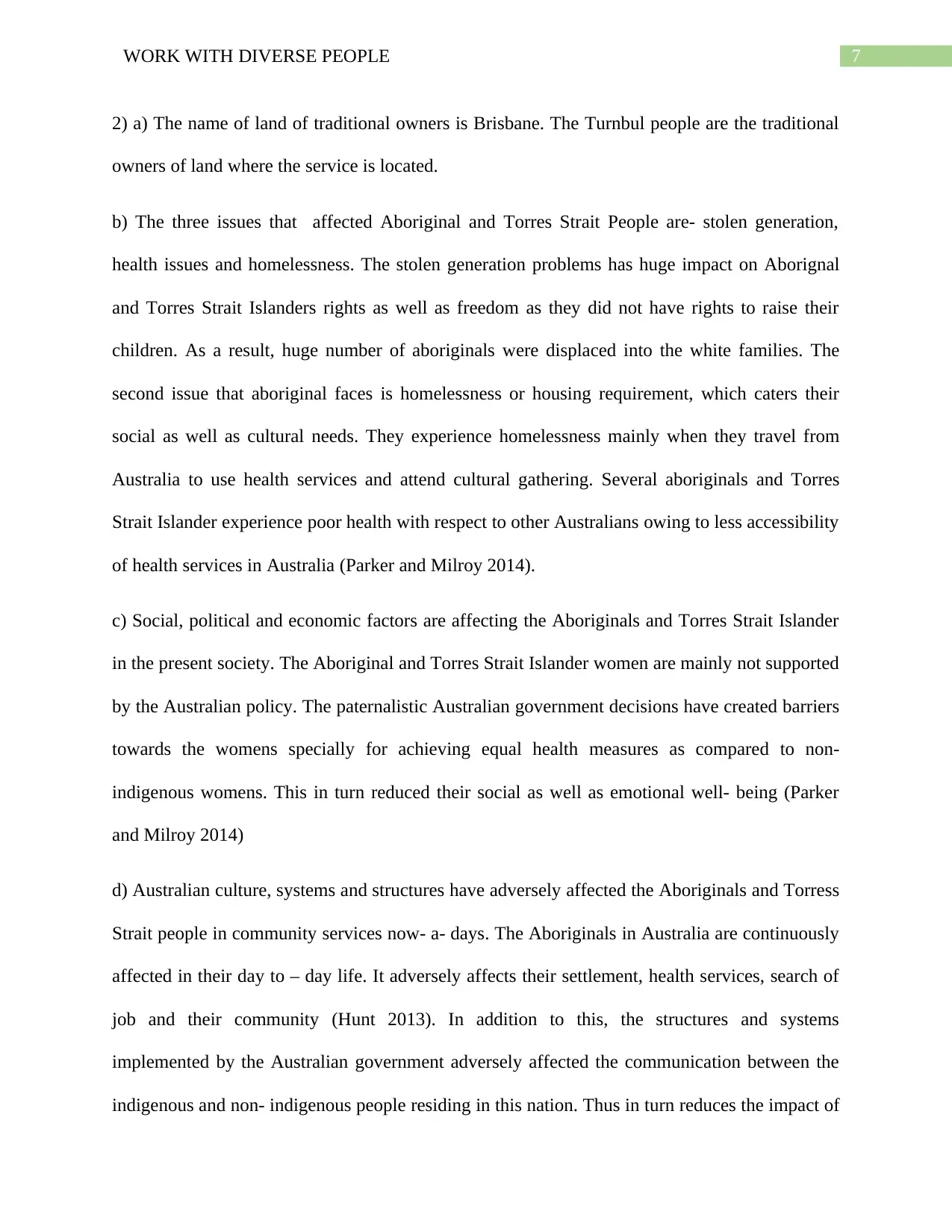
7WORK WITH DIVERSE PEOPLE
2) a) The name of land of traditional owners is Brisbane. The Turnbul people are the traditional
owners of land where the service is located.
b) The three issues that affected Aboriginal and Torres Strait People are- stolen generation,
health issues and homelessness. The stolen generation problems has huge impact on Aborignal
and Torres Strait Islanders rights as well as freedom as they did not have rights to raise their
children. As a result, huge number of aboriginals were displaced into the white families. The
second issue that aboriginal faces is homelessness or housing requirement, which caters their
social as well as cultural needs. They experience homelessness mainly when they travel from
Australia to use health services and attend cultural gathering. Several aboriginals and Torres
Strait Islander experience poor health with respect to other Australians owing to less accessibility
of health services in Australia (Parker and Milroy 2014).
c) Social, political and economic factors are affecting the Aboriginals and Torres Strait Islander
in the present society. The Aboriginal and Torres Strait Islander women are mainly not supported
by the Australian policy. The paternalistic Australian government decisions have created barriers
towards the womens specially for achieving equal health measures as compared to non-
indigenous womens. This in turn reduced their social as well as emotional well- being (Parker
and Milroy 2014)
d) Australian culture, systems and structures have adversely affected the Aboriginals and Torress
Strait people in community services now- a- days. The Aboriginals in Australia are continuously
affected in their day to – day life. It adversely affects their settlement, health services, search of
job and their community (Hunt 2013). In addition to this, the structures and systems
implemented by the Australian government adversely affected the communication between the
indigenous and non- indigenous people residing in this nation. Thus in turn reduces the impact of
2) a) The name of land of traditional owners is Brisbane. The Turnbul people are the traditional
owners of land where the service is located.
b) The three issues that affected Aboriginal and Torres Strait People are- stolen generation,
health issues and homelessness. The stolen generation problems has huge impact on Aborignal
and Torres Strait Islanders rights as well as freedom as they did not have rights to raise their
children. As a result, huge number of aboriginals were displaced into the white families. The
second issue that aboriginal faces is homelessness or housing requirement, which caters their
social as well as cultural needs. They experience homelessness mainly when they travel from
Australia to use health services and attend cultural gathering. Several aboriginals and Torres
Strait Islander experience poor health with respect to other Australians owing to less accessibility
of health services in Australia (Parker and Milroy 2014).
c) Social, political and economic factors are affecting the Aboriginals and Torres Strait Islander
in the present society. The Aboriginal and Torres Strait Islander women are mainly not supported
by the Australian policy. The paternalistic Australian government decisions have created barriers
towards the womens specially for achieving equal health measures as compared to non-
indigenous womens. This in turn reduced their social as well as emotional well- being (Parker
and Milroy 2014)
d) Australian culture, systems and structures have adversely affected the Aboriginals and Torress
Strait people in community services now- a- days. The Aboriginals in Australia are continuously
affected in their day to – day life. It adversely affects their settlement, health services, search of
job and their community (Hunt 2013). In addition to this, the structures and systems
implemented by the Australian government adversely affected the communication between the
indigenous and non- indigenous people residing in this nation. Thus in turn reduces the impact of
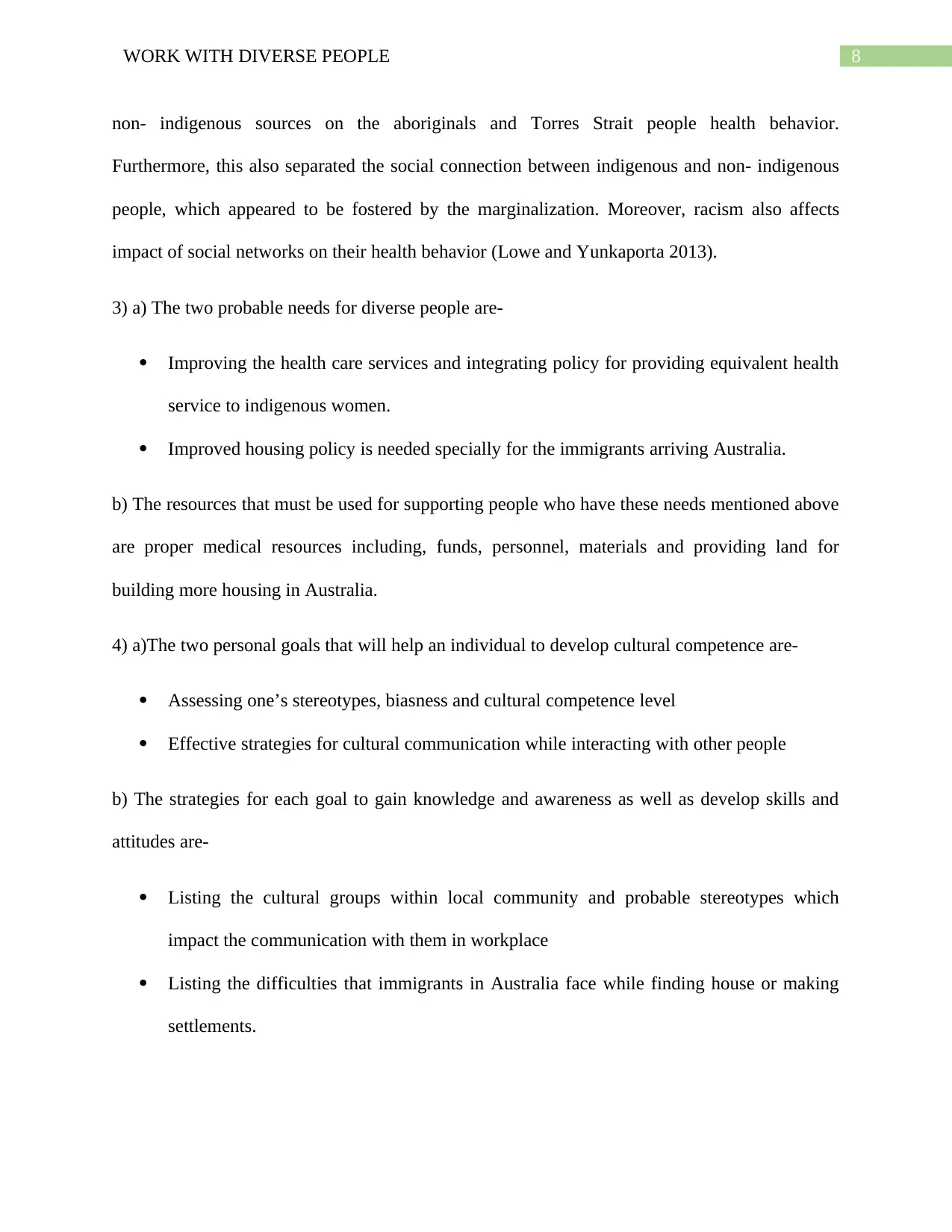
8WORK WITH DIVERSE PEOPLE
non- indigenous sources on the aboriginals and Torres Strait people health behavior.
Furthermore, this also separated the social connection between indigenous and non- indigenous
people, which appeared to be fostered by the marginalization. Moreover, racism also affects
impact of social networks on their health behavior (Lowe and Yunkaporta 2013).
3) a) The two probable needs for diverse people are-
Improving the health care services and integrating policy for providing equivalent health
service to indigenous women.
Improved housing policy is needed specially for the immigrants arriving Australia.
b) The resources that must be used for supporting people who have these needs mentioned above
are proper medical resources including, funds, personnel, materials and providing land for
building more housing in Australia.
4) a)The two personal goals that will help an individual to develop cultural competence are-
Assessing one’s stereotypes, biasness and cultural competence level
Effective strategies for cultural communication while interacting with other people
b) The strategies for each goal to gain knowledge and awareness as well as develop skills and
attitudes are-
Listing the cultural groups within local community and probable stereotypes which
impact the communication with them in workplace
Listing the difficulties that immigrants in Australia face while finding house or making
settlements.
non- indigenous sources on the aboriginals and Torres Strait people health behavior.
Furthermore, this also separated the social connection between indigenous and non- indigenous
people, which appeared to be fostered by the marginalization. Moreover, racism also affects
impact of social networks on their health behavior (Lowe and Yunkaporta 2013).
3) a) The two probable needs for diverse people are-
Improving the health care services and integrating policy for providing equivalent health
service to indigenous women.
Improved housing policy is needed specially for the immigrants arriving Australia.
b) The resources that must be used for supporting people who have these needs mentioned above
are proper medical resources including, funds, personnel, materials and providing land for
building more housing in Australia.
4) a)The two personal goals that will help an individual to develop cultural competence are-
Assessing one’s stereotypes, biasness and cultural competence level
Effective strategies for cultural communication while interacting with other people
b) The strategies for each goal to gain knowledge and awareness as well as develop skills and
attitudes are-
Listing the cultural groups within local community and probable stereotypes which
impact the communication with them in workplace
Listing the difficulties that immigrants in Australia face while finding house or making
settlements.
⊘ This is a preview!⊘
Do you want full access?
Subscribe today to unlock all pages.

Trusted by 1+ million students worldwide
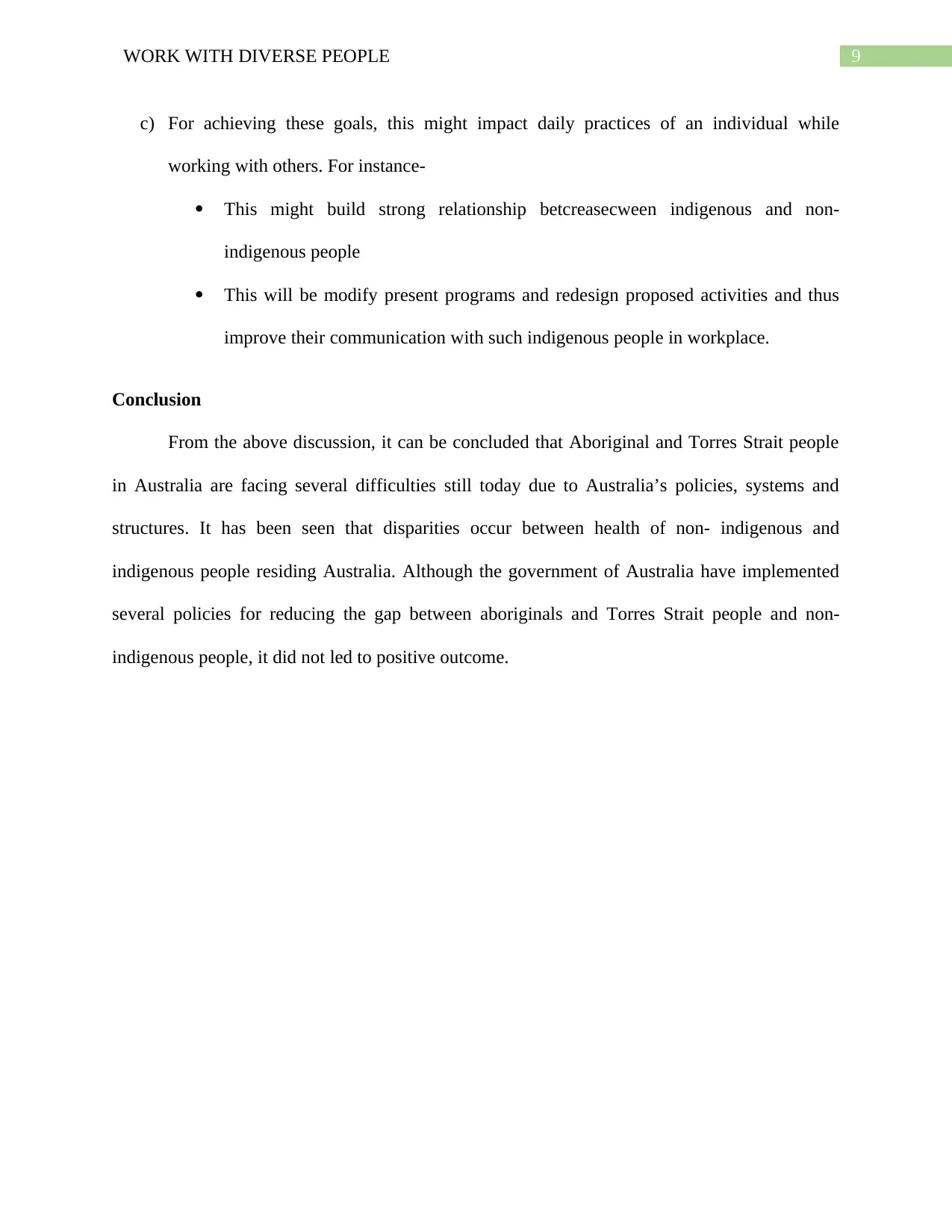
9WORK WITH DIVERSE PEOPLE
c) For achieving these goals, this might impact daily practices of an individual while
working with others. For instance-
This might build strong relationship betcreasecween indigenous and non-
indigenous people
This will be modify present programs and redesign proposed activities and thus
improve their communication with such indigenous people in workplace.
Conclusion
From the above discussion, it can be concluded that Aboriginal and Torres Strait people
in Australia are facing several difficulties still today due to Australia’s policies, systems and
structures. It has been seen that disparities occur between health of non- indigenous and
indigenous people residing Australia. Although the government of Australia have implemented
several policies for reducing the gap between aboriginals and Torres Strait people and non-
indigenous people, it did not led to positive outcome.
c) For achieving these goals, this might impact daily practices of an individual while
working with others. For instance-
This might build strong relationship betcreasecween indigenous and non-
indigenous people
This will be modify present programs and redesign proposed activities and thus
improve their communication with such indigenous people in workplace.
Conclusion
From the above discussion, it can be concluded that Aboriginal and Torres Strait people
in Australia are facing several difficulties still today due to Australia’s policies, systems and
structures. It has been seen that disparities occur between health of non- indigenous and
indigenous people residing Australia. Although the government of Australia have implemented
several policies for reducing the gap between aboriginals and Torres Strait people and non-
indigenous people, it did not led to positive outcome.
Paraphrase This Document
Need a fresh take? Get an instant paraphrase of this document with our AI Paraphraser
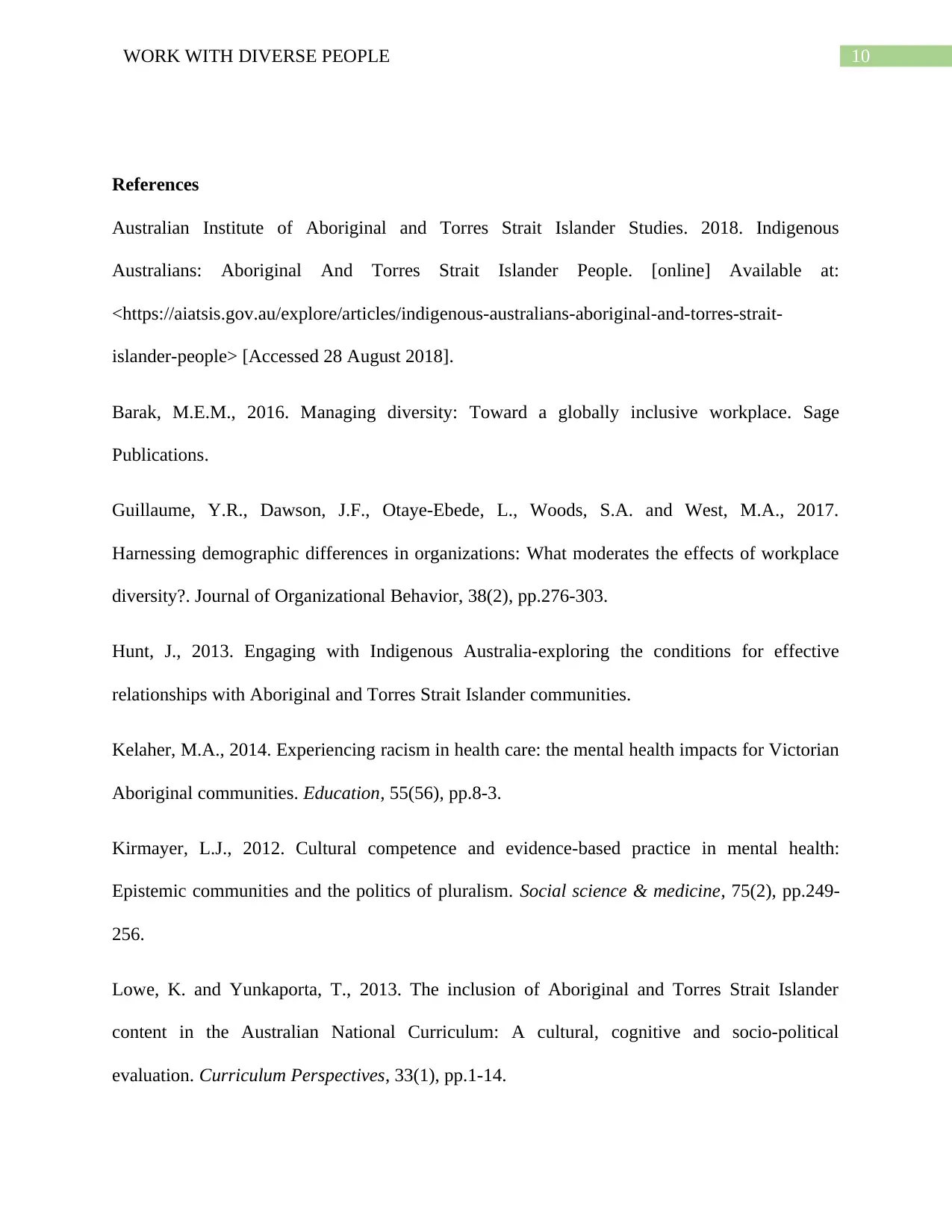
10WORK WITH DIVERSE PEOPLE
References
Australian Institute of Aboriginal and Torres Strait Islander Studies. 2018. Indigenous
Australians: Aboriginal And Torres Strait Islander People. [online] Available at:
<https://aiatsis.gov.au/explore/articles/indigenous-australians-aboriginal-and-torres-strait-
islander-people> [Accessed 28 August 2018].
Barak, M.E.M., 2016. Managing diversity: Toward a globally inclusive workplace. Sage
Publications.
Guillaume, Y.R., Dawson, J.F., Otaye‐Ebede, L., Woods, S.A. and West, M.A., 2017.
Harnessing demographic differences in organizations: What moderates the effects of workplace
diversity?. Journal of Organizational Behavior, 38(2), pp.276-303.
Hunt, J., 2013. Engaging with Indigenous Australia-exploring the conditions for effective
relationships with Aboriginal and Torres Strait Islander communities.
Kelaher, M.A., 2014. Experiencing racism in health care: the mental health impacts for Victorian
Aboriginal communities. Education, 55(56), pp.8-3.
Kirmayer, L.J., 2012. Cultural competence and evidence-based practice in mental health:
Epistemic communities and the politics of pluralism. Social science & medicine, 75(2), pp.249-
256.
Lowe, K. and Yunkaporta, T., 2013. The inclusion of Aboriginal and Torres Strait Islander
content in the Australian National Curriculum: A cultural, cognitive and socio-political
evaluation. Curriculum Perspectives, 33(1), pp.1-14.
References
Australian Institute of Aboriginal and Torres Strait Islander Studies. 2018. Indigenous
Australians: Aboriginal And Torres Strait Islander People. [online] Available at:
<https://aiatsis.gov.au/explore/articles/indigenous-australians-aboriginal-and-torres-strait-
islander-people> [Accessed 28 August 2018].
Barak, M.E.M., 2016. Managing diversity: Toward a globally inclusive workplace. Sage
Publications.
Guillaume, Y.R., Dawson, J.F., Otaye‐Ebede, L., Woods, S.A. and West, M.A., 2017.
Harnessing demographic differences in organizations: What moderates the effects of workplace
diversity?. Journal of Organizational Behavior, 38(2), pp.276-303.
Hunt, J., 2013. Engaging with Indigenous Australia-exploring the conditions for effective
relationships with Aboriginal and Torres Strait Islander communities.
Kelaher, M.A., 2014. Experiencing racism in health care: the mental health impacts for Victorian
Aboriginal communities. Education, 55(56), pp.8-3.
Kirmayer, L.J., 2012. Cultural competence and evidence-based practice in mental health:
Epistemic communities and the politics of pluralism. Social science & medicine, 75(2), pp.249-
256.
Lowe, K. and Yunkaporta, T., 2013. The inclusion of Aboriginal and Torres Strait Islander
content in the Australian National Curriculum: A cultural, cognitive and socio-political
evaluation. Curriculum Perspectives, 33(1), pp.1-14.
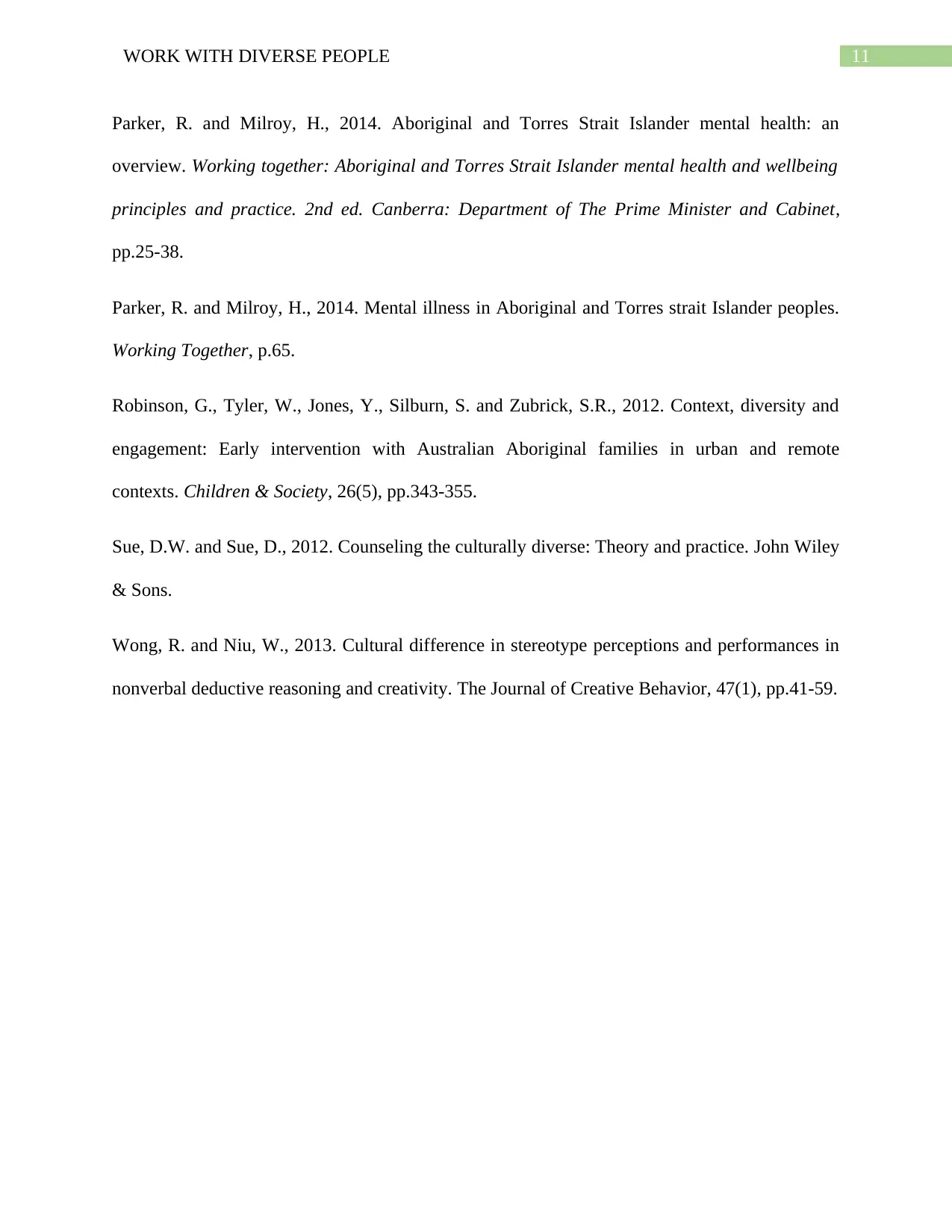
11WORK WITH DIVERSE PEOPLE
Parker, R. and Milroy, H., 2014. Aboriginal and Torres Strait Islander mental health: an
overview. Working together: Aboriginal and Torres Strait Islander mental health and wellbeing
principles and practice. 2nd ed. Canberra: Department of The Prime Minister and Cabinet,
pp.25-38.
Parker, R. and Milroy, H., 2014. Mental illness in Aboriginal and Torres strait Islander peoples.
Working Together, p.65.
Robinson, G., Tyler, W., Jones, Y., Silburn, S. and Zubrick, S.R., 2012. Context, diversity and
engagement: Early intervention with Australian Aboriginal families in urban and remote
contexts. Children & Society, 26(5), pp.343-355.
Sue, D.W. and Sue, D., 2012. Counseling the culturally diverse: Theory and practice. John Wiley
& Sons.
Wong, R. and Niu, W., 2013. Cultural difference in stereotype perceptions and performances in
nonverbal deductive reasoning and creativity. The Journal of Creative Behavior, 47(1), pp.41-59.
Parker, R. and Milroy, H., 2014. Aboriginal and Torres Strait Islander mental health: an
overview. Working together: Aboriginal and Torres Strait Islander mental health and wellbeing
principles and practice. 2nd ed. Canberra: Department of The Prime Minister and Cabinet,
pp.25-38.
Parker, R. and Milroy, H., 2014. Mental illness in Aboriginal and Torres strait Islander peoples.
Working Together, p.65.
Robinson, G., Tyler, W., Jones, Y., Silburn, S. and Zubrick, S.R., 2012. Context, diversity and
engagement: Early intervention with Australian Aboriginal families in urban and remote
contexts. Children & Society, 26(5), pp.343-355.
Sue, D.W. and Sue, D., 2012. Counseling the culturally diverse: Theory and practice. John Wiley
& Sons.
Wong, R. and Niu, W., 2013. Cultural difference in stereotype perceptions and performances in
nonverbal deductive reasoning and creativity. The Journal of Creative Behavior, 47(1), pp.41-59.
⊘ This is a preview!⊘
Do you want full access?
Subscribe today to unlock all pages.

Trusted by 1+ million students worldwide
1 out of 12
Related Documents
Your All-in-One AI-Powered Toolkit for Academic Success.
+13062052269
info@desklib.com
Available 24*7 on WhatsApp / Email
![[object Object]](/_next/static/media/star-bottom.7253800d.svg)
Unlock your academic potential
Copyright © 2020–2025 A2Z Services. All Rights Reserved. Developed and managed by ZUCOL.





